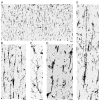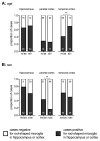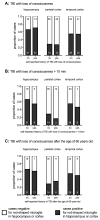Rod-shaped microglia morphology is associated with aging in 2 human autopsy series
- PMID: 28131016
- PMCID: PMC5359029
- DOI: 10.1016/j.neurobiolaging.2016.12.028
Rod-shaped microglia morphology is associated with aging in 2 human autopsy series
Abstract
A subtype of microglia is defined by the morphological appearance of the cells as rod shaped. Little is known about this intriguing cell type, as there are only a few case reports describing rod-shaped microglia in the neuropathological literature. Rod-shaped microglia were shown recently to account for a substantial proportion of the microglia cells in the hippocampus of both demented and cognitively intact aged individuals. We hypothesized that aging could be a defining feature in the occurrence of rod-shaped microglia. To test this hypothesis, 2 independent series of autopsy cases (total n = 168 cases), which covered the adult lifespan from 20 to 100+ years old, were included in the study. The presence or absence of rod-shaped microglia was scored on IBA1 immunohistochemically stained slides for the hippocampus and cortex. We found that age was one of the strongest determinants for the presence of rod-shaped microglia in the hippocampus and the cortex. We found no association with the presence of rod-shaped microglia and a self-reported history of a TBI. Alzheimer's disease-related pathology was found to influence the presence of rod-shaped microglia, but only in the parietal cortex and not in the hippocampus or temporal cortex. Future studies are warranted to determine the functional relevance of rod-shaped microglia in supporting the health of neurons in the aged brain, and the signaling processes that regulate the formation of rod-shaped microglia.
Keywords: Aging; Alzheimer's disease; Hippocampus; Microglia activation; Neurodegeneration; Neuroinflammation; Neuropathology; Traumatic brain injury.
Copyright © 2017 Elsevier Inc. All rights reserved.
Conflict of interest statement
Figures





References
-
- Abner EL, Nelson PT, Kryscio RJ, Schmitt FA, Fardo DW, Woltjer RL, Cairns NJ, Yu L, Dodge HH, Xiong C, Masaki K, Tyas SL, Bennett DA, Schneider JA, Arvanitakis Z. Diabetes is associated with cerebrovascular but not Alzheimer’s disease neuropathology. Alzheimers Dement. 2016;12(8):882–9. - PMC - PubMed
-
- Bachstetter AD, Van Eldik LJ, Schmitt FA, Neltner JH, Ighodaro ET, Webster SJ, Patel E, Abner EL, Kryscio RJ, Nelson PT. Disease-related microglia heterogeneity in the hippocampus of Alzheimer’s disease, dementia with Lewy bodies, and hippocampal sclerosis of aging. Acta Neuropathol Commun. 2015:3. - PMC - PubMed
Publication types
MeSH terms
Grants and funding
LinkOut - more resources
Full Text Sources
Other Literature Sources
Medical

